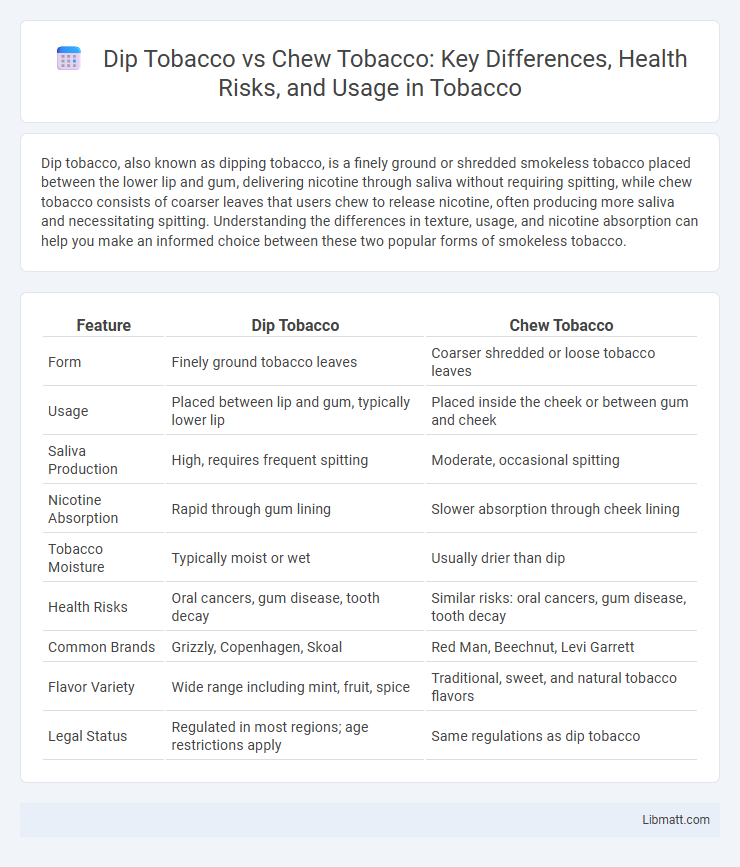Dip tobacco, also known as dipping tobacco, is a finely ground or shredded smokeless tobacco placed between the lower lip and gum, delivering nicotine through saliva without requiring spitting, while chew tobacco consists of coarser leaves that users chew to release nicotine, often producing more saliva and necessitating spitting. Understanding the differences in texture, usage, and nicotine absorption can help you make an informed choice between these two popular forms of smokeless tobacco.
Table of Comparison
| Feature | Dip Tobacco | Chew Tobacco |
|---|---|---|
| Form | Finely ground tobacco leaves | Coarser shredded or loose tobacco leaves |
| Usage | Placed between lip and gum, typically lower lip | Placed inside the cheek or between gum and cheek |
| Saliva Production | High, requires frequent spitting | Moderate, occasional spitting |
| Nicotine Absorption | Rapid through gum lining | Slower absorption through cheek lining |
| Tobacco Moisture | Typically moist or wet | Usually drier than dip |
| Health Risks | Oral cancers, gum disease, tooth decay | Similar risks: oral cancers, gum disease, tooth decay |
| Common Brands | Grizzly, Copenhagen, Skoal | Red Man, Beechnut, Levi Garrett |
| Flavor Variety | Wide range including mint, fruit, spice | Traditional, sweet, and natural tobacco flavors |
| Legal Status | Regulated in most regions; age restrictions apply | Same regulations as dip tobacco |
Introduction to Dip and Chew Tobacco
Dip tobacco, also known as moist snuff, consists of finely ground tobacco leaves placed between the gum and lip, producing a strong nicotine absorption. Chew tobacco comes in loose leaves or plugs that users chew to release nicotine and flavors, making it less discreet but longer-lasting. Both products contain high levels of nicotine and carcinogens, posing significant health risks such as oral cancer and gum disease.
What is Dip Tobacco?
Dip tobacco, also known as dipping tobacco, is a type of smokeless tobacco finely ground and placed between the lip and gum, delivering nicotine through oral absorption. Unlike chew tobacco, which consists of larger leaf pieces meant for chewing, dip tobacco is designed for spitting out excess saliva containing tobacco juices. Your choice between dip and chew tobacco can affect the intensity of nicotine absorption and the manner in which you use the product.
What is Chew Tobacco?
Chew tobacco, also known as chewing tobacco, is a smokeless tobacco product consisting of shredded or loose leaves intended for oral use by placing it between the cheek and gum. Unlike dip tobacco, which is finely ground and designed to be placed in the lip, chew tobacco is coarser and must be chewed or held in the mouth to release nicotine. Prolonged use of chew tobacco is linked to significant health risks, including oral cancer, gum disease, and tooth decay.
Key Differences Between Dip and Chew Tobacco
Dip tobacco involves finely ground tobacco placed between the lip and gum, producing nicotine absorption through oral mucosa, while chew tobacco consists of coarser strands or plugs chewed for juice extraction. Dip tobacco typically has higher nicotine content and less spitting compared to chew tobacco, which often results in more saliva and requires frequent expectoration. The physical texture and usage methods distinguish dip tobacco's discreet and quick consumption from the longer, more intense chewing experience of chew tobacco.
Methods of Use: Dip vs Chew
Dip tobacco involves placing a small pinch of finely ground tobacco between your lower lip and gum, allowing nicotine absorption through the oral mucosa. Chew tobacco consists of larger, coarser leaves that you actively chew to release nicotine and flavor, often requiring frequent spitting of saliva. Your choice between dip and chew depends on preference for either discreet, steady nicotine intake or a more active, oral stimulation experience.
Popular Brands and Flavors
Popular dip tobacco brands include Copenhagen, Skoal, and Grizzly, offering flavors such as mint, wintergreen, and natural tobacco. Chew tobacco brands like Red Man and Levi Garrett are known for their classic, sweet, and robust flavors, often featuring molasses and honey undertones. Both forms provide a range of flavor profiles catering to different preferences within smokeless tobacco users.
Health Risks and Side Effects
Dip tobacco and chew tobacco both pose significant health risks, including increased chances of oral cancer, gum disease, and tooth decay. Dip tobacco, placed between the gum and lip, often delivers higher nicotine levels leading to addiction and elevated risks of heart disease. Chew tobacco, which requires constant chewing, can cause mouth sores, dental erosion, and an increased risk of esophageal and pancreatic cancers.
Social and Cultural Perspectives
Dip tobacco and chew tobacco hold distinct social and cultural significance within various communities, with dip tobacco often associated with urban and rural male subcultures, while chew tobacco is more prevalent in traditional, rural farming areas. These products symbolize camaraderie and shared identity but also carry stigmas tied to health concerns and changing social norms. Your understanding of these perspectives can provide deeper insight into the cultural values and social dynamics surrounding tobacco use.
Tips for Quitting Smokeless Tobacco
Quitting smokeless tobacco, whether dip or chew tobacco, involves setting a quit date and using nicotine replacement therapies like patches or gum to manage cravings effectively. Behavioral strategies such as identifying triggers, chewing sugar-free gum, and seeking support through counseling or quitlines significantly increase success rates. Monitoring progress with a journal and avoiding situations where the urge to use arises help maintain long-term abstinence from smokeless tobacco.
Conclusion: Which is Right for You?
Choosing between dip tobacco and chew tobacco depends on your personal preferences and lifestyle, as both pose significant health risks such as oral cancer and gum disease. Dip tobacco is typically more discreet and offers a quicker nicotine release, while chew tobacco involves prolonged chewing and may produce more saliva. Understanding these differences helps you make an informed decision that aligns with your tobacco use habits and health considerations.
dip tobacco vs chew tobacco Infographic

 libmatt.com
libmatt.com